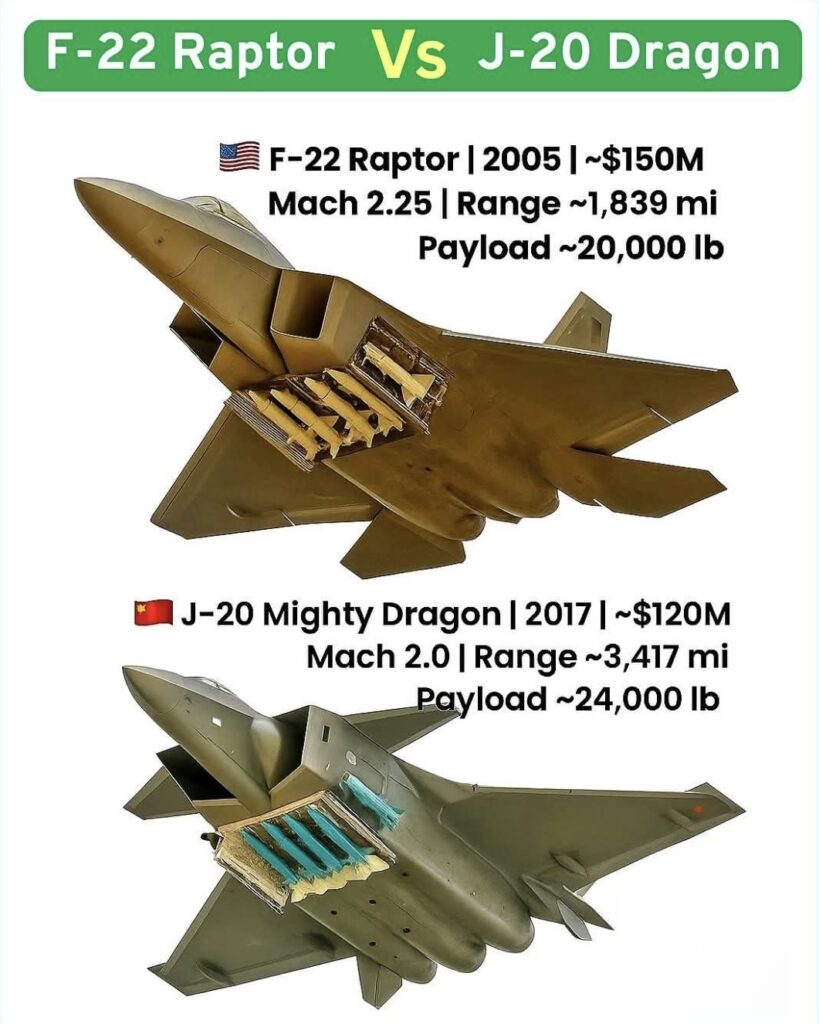
The rivalry between the American F-22 Raptor and China’s Chengdu J-20 “Mighty Dragon” represents the forefront of modern air combat technology. Both are fifth-generation stealth fighters designed to dominate the skies, but they come from very different philosophies and priorities. While the F-22 was built primarily for air superiority with unmatched agility and stealth, the J-20 emphasizes long-range capabilities and advanced sensors, reflecting China’s focus on countering U.S. air power in the Asia-Pacific region.
The F-22 Raptor, developed by Lockheed Martin and introduced in 2005, remains one of the most advanced fighters in the world. It was designed to ensure the United States maintained air dominance well into the 21st century. The aircraft features twin Pratt & Whitney F119-PW-100 engines with thrust vectoring, giving it exceptional maneuverability and speed—capable of supercruise (sustained supersonic flight) without afterburners. The F-22’s radar cross-section is extremely small, thanks to its stealthy design, radar-absorbent materials, and careful shaping. Combined with its AN/APG-77 AESA radar and integrated avionics, the Raptor can detect and track multiple targets while remaining nearly invisible to enemy radar.
Armament-wise, the F-22 carries a mix of AIM-120 AMRAAM and AIM-9 Sidewinder missiles in internal bays, preserving its stealth profile. It can also carry precision-guided bombs for ground attacks, though its primary mission remains air superiority. The Raptor’s combination of speed, stealth, and agility makes it an almost unbeatable opponent in dogfights. However, high production costs and maintenance demands limited the U.S. Air Force to just 187 operational units, which restricts its availability compared to newer aircraft.
On the other side, the J-20 Mighty Dragon, developed by China’s Chengdu Aerospace Corporation, entered service around 2017. It represents China’s ambition to close the gap with Western air power and project strength in regional conflicts. The J-20’s design prioritizes long-range interception and stealth, with a sleek delta-wing and canard configuration. While early models used Russian AL-31 engines, newer versions are equipped with China’s indigenous WS-15 engines, improving thrust and efficiency.
The J-20’s strength lies in its advanced sensor suite and networking capabilities. It uses an AESA radar comparable to the F-22’s and is believed to have strong electronic warfare systems. The aircraft is also designed to carry long-range PL-15 air-to-air missiles, allowing it to engage targets well before visual range. Its large internal weapons bays and long operational range suggest that China envisions the J-20 as a platform to control airspace over the South China Sea and beyond, rather than engaging in close-range dogfights.
When comparing the two, the F-22 Raptor still has the edge in maneuverability and proven combat readiness. The J-20, however, offers greater range and may have an advantage in long-distance engagements, supported by China’s growing network of sensors and support aircraft. The Raptor is a refined air-superiority fighter born from decades of U.S. air dominance strategy, while the J-20 reflects a new kind of warfare—where stealth, long-range detection, and data integration matter as much as speed and agility.
In the end, a direct clash between the two is unlikely, but their ongoing development symbolizes the shifting balance of global air power. The F-22 represents legacy dominance, while the J-20 is the rising challenger—both defining the future of modern aerial combat.


